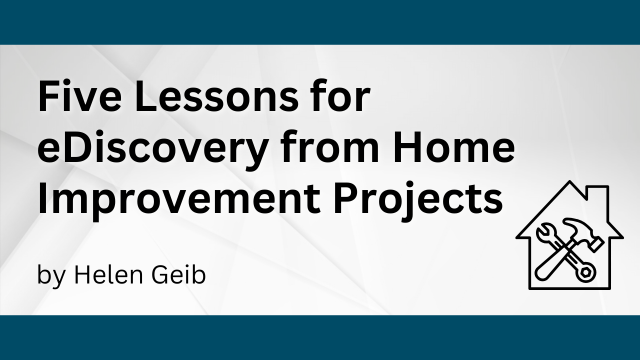
[EDRM Editor’s Note: The opinions and positions are those of Helen Geib.]
The last few months I’ve been in the throes of multiple home improvement projects large and small requiring eight contractors and two handyman services. And what, you ask, does this have to do with eDiscovery? This experience has opened my eyes to the many commonalities between home improvement and document discovery.
Here are five lessons to be learned from home improvement for successfully managing an eDiscovery project:
1. Due diligence is a must.
Neighbors recommended the roofing company. I found the first handyman on Angi. For the rest I did a lot of internet research, studying websites and vetting customer reviews.
When it comes time to select eDiscovery software or service providers your professional network is a great resource for “friends and family” referrals. Discovery doesn’t have an exact corollary to review aggregator sites, but there is a lot of information available online in industry publications, vendor databases and webinars. Some providers offer demos. If your service provider is in-house litigation support, they’ll help you select the best tools for your project.
2. Scope out the project before moving forward.
A good contractor will come to your house before giving a quote. The site visit allows them to fully scope out the project, including picking up on details you may have missed. It’s also an opportunity for both of you to ask questions.
Similarly, project scoping in eDiscovery sets up your project for success. Collaboration between case team and service provider is an important part of this process. Actual meetings and phone calls are never a bad idea and are highly recommended if the project is complicated or unusual. They’re a must when it’s your first project together.
Actual meetings and phone calls are never a bad idea and are highly recommended if the project is complicated or unusual. They’re a must when it’s your first project together.
Helen Geib, Hoover Hull Turner LLP.
3. Set expectations for communications.
Whether home improvement or eDiscovery, the scoping stage is an opportune time to set expectations for communications: who should be contacted about what; frequency (scheduled and/or as needed); means (meetings, calls, texts); and invoicing details.
4. Budget time for prep work.
It takes a surprising amount of time and labor to get your house ready for somebody else to work on it. Mostly moving stuff from one part of the house to another and back again.
Thankfully the practice of law doesn’t involve heavy lifting (aside from the occasional scanning project…). However, eDiscovery preparation does require another type of moving, namely the gathering and sharing of information. Your specific area of responsibility may be a big category like data source identification or a discrete line item like processing time zone. Whatever your role, don’t cut corners on prep time. Accurate and complete information is the foundation of a successful eDiscovery project.
5. Speaking of budgeting, realistic budgets are the first step in avoiding cost overruns.
The most obvious similarity between home improvement and eDiscovery projects is their tendency to go over budget. I have a couple of suggestions to help you avoid unpleasant surprises at invoicing time. First, take advantage of the work you already put into project scoping. A comprehensive and realistic budget is based on detailed information; for example, an email mailbox size report for identified custodians is going to be a lot more accurate than plugging in industry data volume assumptions. Second, build in a cushion for foreseeable additional costs such as locating another data source or a forensic investigation taking longer than initially projected.
A comprehensive and realistic budget is based on detailed information; for example, an email mailbox size report for identified custodians is going to be a lot more accurate than plugging in industry data volume assumptions.
Helen Geib, Hoover Hull Turner LLP.
If you found these pointers helpful, stay tuned for part two when I’ll offer four more lessons for eDiscovery from home improvement projects.
Assisted by GAI and LLM Technologies per EDRM GAI and LLM Policy.


